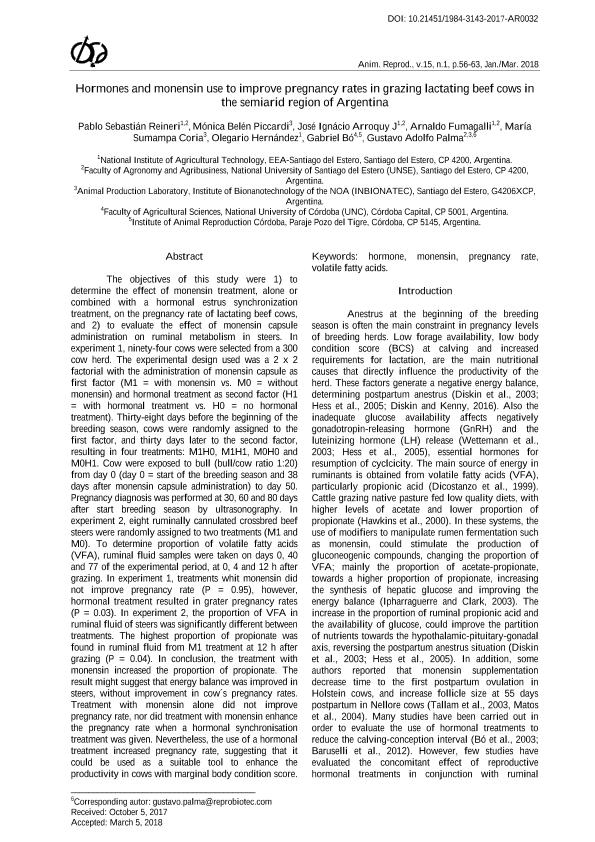Artículo
Hormones and monensin use to improve pregnancy rates in grazing lactating beef cows in the semiarid region of Argentina
Reineri, Pablo Sebastian; Piccardi, Mónica Belén ; Arroquy, Jose Ignacio
; Arroquy, Jose Ignacio ; Fumagalli, Arnaldo Enrique; Coria, Maria Sumampa
; Fumagalli, Arnaldo Enrique; Coria, Maria Sumampa ; Hernandez, Olegario; Bo, Gabriel Amilcar; Palma, Gustavo Adolfo
; Hernandez, Olegario; Bo, Gabriel Amilcar; Palma, Gustavo Adolfo
 ; Arroquy, Jose Ignacio
; Arroquy, Jose Ignacio ; Fumagalli, Arnaldo Enrique; Coria, Maria Sumampa
; Fumagalli, Arnaldo Enrique; Coria, Maria Sumampa ; Hernandez, Olegario; Bo, Gabriel Amilcar; Palma, Gustavo Adolfo
; Hernandez, Olegario; Bo, Gabriel Amilcar; Palma, Gustavo Adolfo
Fecha de publicación:
06/2018
Editorial:
Colégio Brasileiro de Reprodução Animal
Revista:
Animal Reproduction
ISSN:
1806-9614
e-ISSN:
1984-3143
Idioma:
Inglés
Tipo de recurso:
Artículo publicado
Clasificación temática:
Resumen
The objectives of this study were 1) to determine the effect of monensin treatment, alone or combined with a hormonal estrus synchronization treatment, on the pregnancy rate of lactating beef cows, and 2) to evaluate the effect of monensin capsule administration on ruminal metabolism in steers. In experiment 1, ninety-four cows were selected from a 300 cow herd. The experimental design used was a 2 × 2 factorial with the administration of monensin capsule as first factor (M1 = with monensin vs. M0 = without monensin) and hormonal treatment as second factor (H1 = with hormonal treatment vs. H0 = no hormonal treatment). Thirty-eight days before the beginning of the breeding season, cows were randomly assigned to the first factor, and thirty days later to the second factor, resulting in four treatments: M1H0, M1H1, M0H0 and M0H1. Cow were exposed to bull (bull/cow ratio 1:20) from day 0 (day 0 = start of the breeding season and 38 days after monensin capsule administration) to day 50. Pregnancy diagnosis was performed at 30, 60 and 80 days after start breeding season by ultrasonography. In experiment 2, eight ruminally cannulated crossbred beef steers were randomly assigned to two treatments (M1 and M0). To determine proportion of volatile fatty acids (VFA), ruminal fluid samples were taken on days 0, 40 and 77 of the experimental period, at 0, 4 and 12 h after grazing. In experiment 1, treatments whit monensin did not improve pregnancy rate (P = 0.95), however, hormonal treatment resulted in grater pregnancy rates (P = 0.03). In experiment 2, the proportion of VFA in ruminal fluid of steers was significantly different between treatments. The highest proportion of propionate was found in ruminal fluid from M1 treatment at 12 h after grazing (P = 0.04). In conclusion, the treatment with monensin increased the proportion of propionate. The result might suggest that energy balance was improved in steers, without improvement in cow's pregnancy rates. Treatment with monensin alone did not improve pregnancy rate, nor did treatment with monensin enhance the pregnancy rate when a hormonal synchronisation treatment was given. Nevertheless, the use of a hormonal treatment increased pregnancy rate, suggesting that it could be used as a suitable tool to enhance the productivity in cows with marginal body condition score.
Palabras clave:
HORMONE
,
MONENSIN
,
PREGNANCY RATE
,
VOLATILE FATTY ACIDS
Archivos asociados
Licencia
Identificadores
Colecciones
Articulos(CCT - CORDOBA)
Articulos de CTRO.CIENTIFICO TECNOL.CONICET - CORDOBA
Articulos de CTRO.CIENTIFICO TECNOL.CONICET - CORDOBA
Articulos(INBIONATEC)
Articulos de INSTITUTO DE BIONANOTECNOLOGIA DEL NOA
Articulos de INSTITUTO DE BIONANOTECNOLOGIA DEL NOA
Citación
Reineri, Pablo Sebastian; Piccardi, Mónica Belén; Arroquy, Jose Ignacio; Fumagalli, Arnaldo Enrique; Coria, Maria Sumampa; et al.; Hormones and monensin use to improve pregnancy rates in grazing lactating beef cows in the semiarid region of Argentina; Colégio Brasileiro de Reprodução Animal; Animal Reproduction; 15; 1; 6-2018; 56-63
Compartir
Altmétricas



